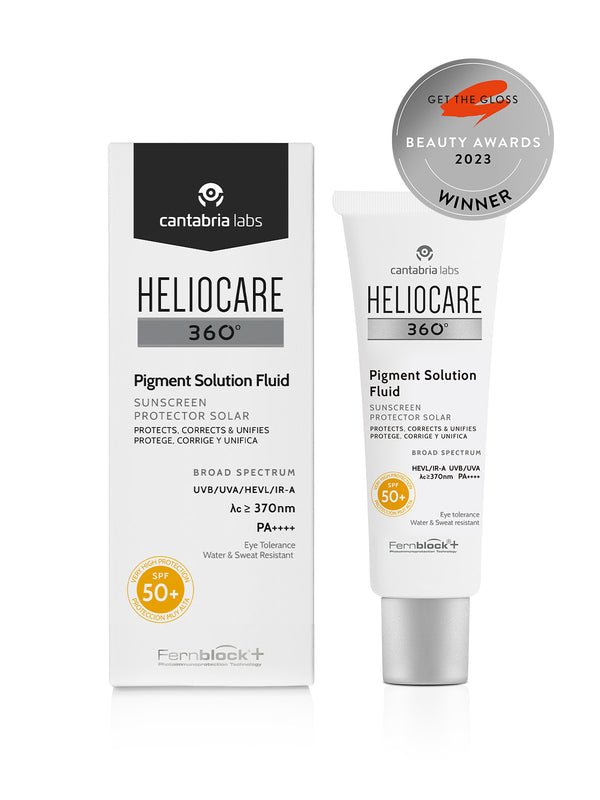Hyperpigmentation: what is it, and how can we prevent it?
Hyperpigmentation is a common skin concern. Some different types of hyperpigmentation include post-inflammatory hyperpigmentation (PIH), melasma and age spots. The condition can be caused by infections, pregnancy and different medications, but most often, it is the result of sun damage. So how should sun-induced hyperpigmentation be treated, and how can we prevent it from happening in the first place?
The role of melanin
To understand hyperpigmentation, we first need to understand melanin. Melanin is a pigment that produces different shades of skin, hair and eye colour. Our colouring is determined by the amount of melanin in our melanocytes, specialised cells that are scattered deep within the basal layer of skin1. Melanin is usually distributed evenly throughout the skin, but sometimes it is gathered in spots or patches, which might appear as freckles.
We all carry the same number of melanocytes, but we produce different levels of melanin. This is down to our genes. If we produce more melanin, our skin is darker. If we produce less melanin, our skin is lighter.
While genetics play a big role in our colouring, sun exposure also influences melanin production. When we expose our skin to the sun’s rays, our melanocyte cells immediately realise there could be damage, and so they produce more of the pigment melanin. This overproduction is a protective mechanism, because melanin absorbs UV rays and protects the outer layer of the skin. Prolonged sun exposure will produce more melanin, which is what gives us a tan and darkens areas that are already hyperpigmented. Sometimes, there is an uneven increase in melanin, which causes irregular colouring. And years of accumulated sun damage will lead to long-term discolouration, also known as hyperpigmentation.
Different types of pigmentation
Pigmentation may be localised or diffused in presentation2. Different types of pigmentation disorders include depigmentation, hypopigmentation and hyperpigmentation. Depigmentation is the total loss of pigment, making patches of skin white. This is known as vitiligo3. Hypopigmentation is an unusually low amount of melanin, which makes the skin lighter. This can be caused by injuries like blisters, burns or chemical exposures, as well as inflammatory conditions like psoriasis and dermatitis. Widespread hypopigmentation occurs in albinism4.
Finally, hyperpigmentation is caused by too much melanin. This often occurs as spots, more commonly known as age spots or liver spots. These appear anywhere on the body (but most often the face and hands, as they are frequently exposed to the sun). Hyperpigmentation affects people of all ages, ethnicities and skin types.
How to treat and prevent hyperpigmentation
There are a number of treatments available for hyperpigmentation. These include peels, laser, IPL and dermabrasion5. Topical acids and retinol can also help to treat the condition. However, no matter the course of action you take for treating hyperpigmentation, sun protection is essential, and anyone seeking hyperpigmentation treatment should use sunscreen on a daily basis6.
The single best way to protect the skin from hyperpigmentation and other effects of sun damage is to avoid direct sunlight, especially during the peak hours of 10am - 2pm. Hats and clothing will also help to protect your skin from the sun. Finally, you should apply a broad spectrum, high factor SPF every single day, even when it’s not sunny. This will help to protect against UVA, UVB, visible light and infrared-A, all of which contribute to sun damage, premature skin ageing and pigmentation.
That’s where Heliocare 360° comes in. This award-winning professional sun protection range is the perfect choice for preventing sun-induced hyperpigmentation, particularly our Heliocare 360° Pigment Solution Fluid SPF 50+. As well as offering full-spectrum protection, this formulation contains a depigmenting system which helps to prevent and improve hyperpigmentation, while a subtle nude pigment helps to unify skin tone for immediate correction. Our Pigment Solution Fluid is packed with intelligent skin-loving ingredients, including DNA repair enzymes, vitamins C and E and green tea extract. The depigmenting complex features niacinamide and ellagic acid, while the supercharged anti-oxidant Fernblock® provides multiple levels of protection to prevent short-term UV damage and the long-term effects of sun exposure.
Protect your skin like never before, correct existing hyperpigmentation and prevent further damage from taking place. Shop Heliocare 360° and discover our amazing Pigment Solution Fluid and bundle deals today.
In the article

- For skin with light-induced pigmentation
- Suitable for Fitzpatrick skin types I-IV
- SPF50 & PA++++
- Lifts and helps to prevent pigmentation
References:
1 MSD Manual Consumer Version. (n.d.). Overview of Skin Pigment - Skin Disorders. [online] Available at: https://www.msdmanuals.com/home/skin-disorders/pigment-disorders/overview-of-skin-pigment [Accessed 13 Jun. 2022].
2 Desai, S.R. (2014). Hyperpigmentation Therapy: A Review. The Journal of Clinical and Aesthetic Dermatology, [online] 7(8), p.13. Available at: https://www.ncbi.nlm.nih.gov/pmc/articles/PMC4142815/.
3 MSD Manual Consumer Version. (n.d.). Vitiligo - Skin Disorders. [online] Available at: https://www.msdmanuals.com/home/skin-disorders/pigment-disorders/vitiligo [Accessed 13 Jun. 2022].
4 MSD Manual Consumer Version. (n.d.). Albinism - Skin Disorders. [online] Available at: https://www.msdmanuals.com/home/skin-disorders/pigment-disorders/albinism.
5 Cherney, K. (2018). 8 Treatment Options for Hyperpigmentation. [online] Healthline. Available at: https://www.healthline.com/health/beauty-skin-care/hyperpigmentation-treatment.
6 Desai, S.R. (2014). Hyperpigmentation Therapy: A Review. The Journal of Clinical and Aesthetic Dermatology, [online] 7(8), p.13. Available at: https://www.ncbi.nlm.nih.gov/pmc/articles/PMC4142815/.






